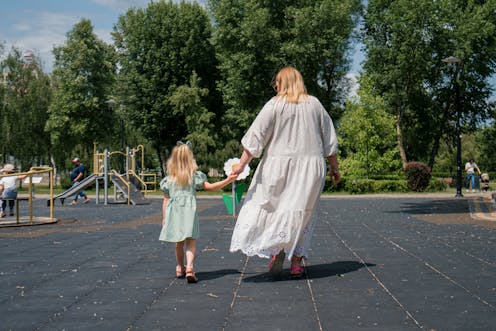Child abductions can be hard to identify, and people may not know they are witnessing a serious crime
- Written by Hayley Cullen, Lecturer, Macquarie University

On a summer’s day in January 1970, three-year-old Cheryl Grimmer was kidnapped from Fairy Meadow Beach in Wollongong, New South Wales. This is the last time Cheryl was seen. Cheryl remains missing[1], 53 years later. She is one of the 2,500 people considered to be a long-term missing person in Australia.
In 2020, the New South Wales government offered[2] a $1,000,000 reward to anyone who could provide information to help locate and arrest the person who abducted Cheryl. Yet, even with this large reward, witnesses were not forthcoming. The only information witnesses at the beach on that day could provide about the girl’s kidnapper was that they were an unknown male.
In 2022, the BBC released a podcast[3] about Cheryl’s case, “Fairy Meadow”. After listening to the podcast, an anonymous witness has recently come forward with a more detailed description[4] of the unknown male, such as his age, hair and build. This new information may help police to finally find Cheryl’s kidnapper after half a century of searching.
Some might question why the anonymous witness did not come forward sooner with information about Cheryl’s abduction. The witness claimed[5] he clearly remembered seeing a teenage male holding a young child on their hip on that day at Fairy Meadow Beach and moving towards the car park. Even though he reported the child was screaming, he did not think the child was being abducted. It was only when hearing the podcast that the witness became aware of the gravity of what he had seen 50 years before.
Kidnapping is a prime example of an ambiguous crime. Imagine you are shopping at your local mall. You see a young child interacting with an adult. The child and the adult leave together, and the child is calm. You would probably think the child and the adult know each other; perhaps the adult is the child’s parent or carer. Even if the child was distressed, you may still think the child was just having a tantrum with an adult known to them. While these interpretations might be normal or common, they may not always be correct.
Children may leave with strangers who are trying to kidnap them without resisting or struggling. This was true of a Brisbane case in 2019[6], when Sterling Mervyn Free was able to convince a young child to follow him out of a busy department store. Many people would have been unconcerned when they saw the two leave the store together. Free sexually assaulted the young child before returning her to the store.
Read more: Cleo Smith case: how 'cognitive interviewing' can help police compile the most reliable evidence[7]
Some of Australia’s most terrifying crimes involve children who have been abducted by strangers, such as the tragic case of Daniel Morcombe[8]. Yet, even though kidnappings are often ambiguous and can occur in very public spaces, there has been limited research dedicated to understanding how such crimes are interpreted by witnesses.
Our research team conducted two experiments to explore whether interpreting a kidnapping as a crime would depend upon the level of ambiguity of the kidnap itself. In our experiments[9], university psychology students watched a video of a bus stop scene. In the video, several people waited for their bus to arrive, including a young female child. The child was sitting at the bus stop by herself. She was approached by a female adult, who started a conversation with her that was not audible to participants.
Participants saw slightly different endings of the bus stop video. In one version, the child and the adult did not leave the bus stop. In a second version, the child and the adult left together without the child resisting. In the third version, the child and the adult left, but the child physically resisted and audibly called out for help.
Later in the experiment, we asked participants whether they believed that what they saw in the video was a crime. Importantly, these students did not know that they would see a crime in the video; we used a cover story to mask our research aims.
In our first experiment, we found that only 34.8% of participants who saw the child leave with the woman without resistance interpreted this as a crime. However, less than half (46.7%) of participants who saw the video where the child struggled and called out for help interpreted this as a crime. Participants in this first experiment were given realistic tasks to complete while they watched the video, such as counting how many buses stopped at the bus stop.
In our second experiment, when we minimised these distracting tasks, closer to three-quarters of participants interpreted both versions of the kidnapping as a crime.
These results tell us a key reason why witnesses do not provide information about child abductions is that they may fail to interpret these events as crimes in the first place. This could be the case even when children show clear signs of distress, just as the anonymous witness claimed Cheryl Grimmer did on that fateful day.
References
- ^ remains missing (www.missingpersons.gov.au)
- ^ offered (www.police.nsw.gov.au)
- ^ podcast (www.bbc.co.uk)
- ^ more detailed description (www.abc.net.au)
- ^ claimed (www.bbc.com)
- ^ Brisbane case in 2019 (www.theguardian.com)
- ^ Cleo Smith case: how 'cognitive interviewing' can help police compile the most reliable evidence (theconversation.com)
- ^ Daniel Morcombe (www.abc.net.au)
- ^ our experiments (ncbi.nlm.nih.gov)
Authors: Hayley Cullen, Lecturer, Macquarie University










